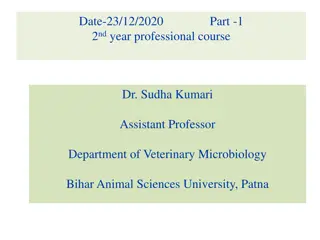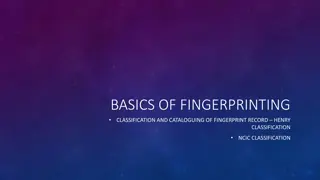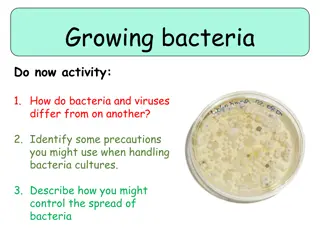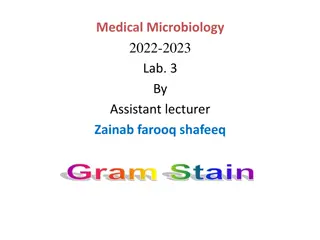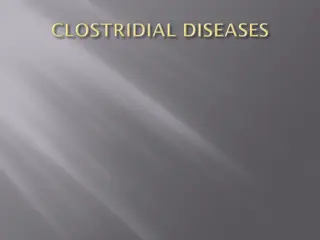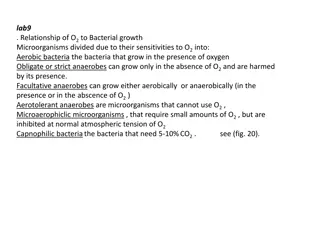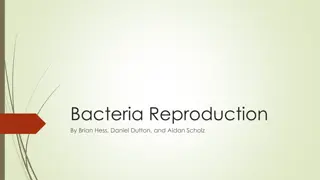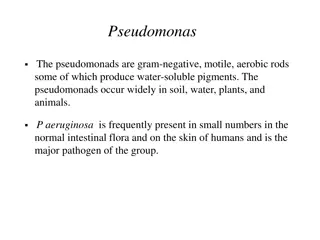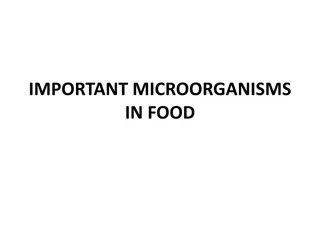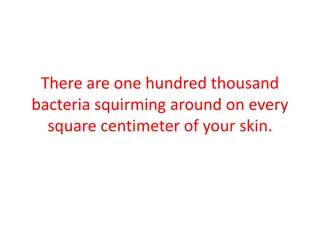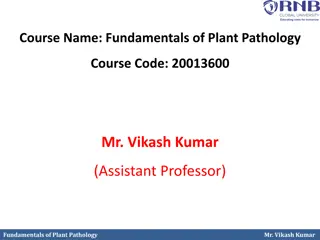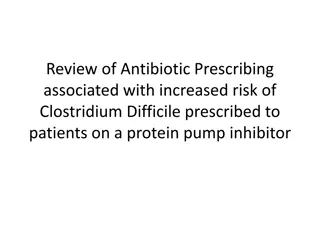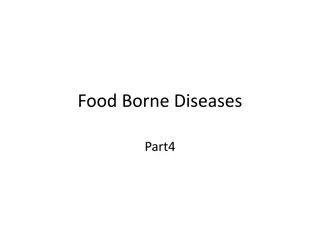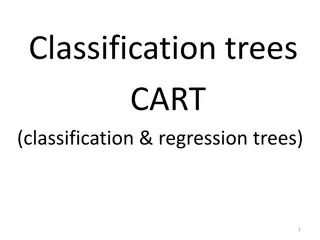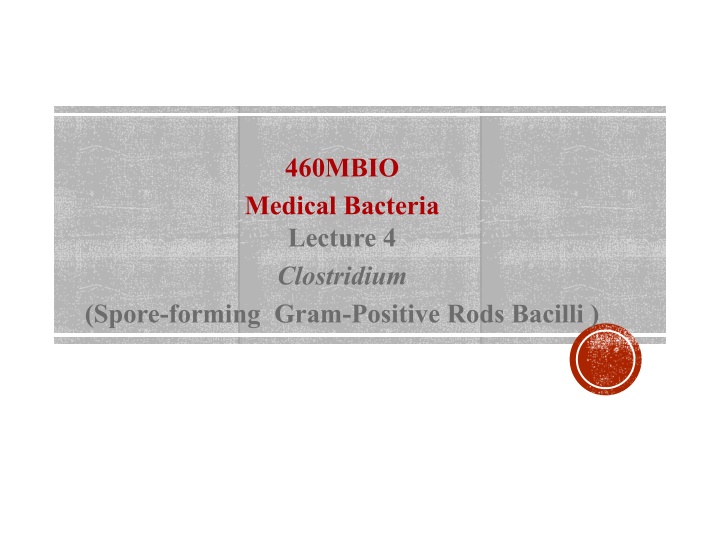
Clostridium Bacteria: General Characteristics and Classification
Clostridium bacteria, known for producing various extracellular enzymes for biodegradation, play crucial roles in nature. Their large, gram-positive rod-shaped morphology, endospore formation, and obligate anaerobic metabolism distinguish them. The classification of Clostridium based on biochemical activity and spore characteristics is essential for understanding diseases caused by these bacteria, such as tetanus. Treatment methods, including antibiotics and wound debridement, are outlined, emphasizing the significance of spore position and shape in classification.
Download Presentation

Please find below an Image/Link to download the presentation.
The content on the website is provided AS IS for your information and personal use only. It may not be sold, licensed, or shared on other websites without obtaining consent from the author. If you encounter any issues during the download, it is possible that the publisher has removed the file from their server.
You are allowed to download the files provided on this website for personal or commercial use, subject to the condition that they are used lawfully. All files are the property of their respective owners.
The content on the website is provided AS IS for your information and personal use only. It may not be sold, licensed, or shared on other websites without obtaining consent from the author.
E N D
Presentation Transcript
460MBIO Medical Bacteria Lecture 4 Clostridium (Spore-forming Gram-Positive Rods Bacilli )
Clostridium General Characteristics The clostridia produce a wide variety of extracellular enzymes to degrade large biological molecules (e.g. proteins, lipids, collagen, cellulose, etc.) in the environment. Thereby, clostridia play an important role in nature in biodegradation and the carbon cycle. Most of the clostridia are saprophytes and a few are pathogenic for humans, e.g. C. tetani C. botulinum C. perfringens C. difficile 1
Morphology: Large, gram-positive- rod shaped (typically large bacilli straight or slightly curved and mostly with rounded end) All species form endospores (spores are located terminally or sub terminally) Obligatory anaerobic )the metabolism type is strictly fermentative , clostridia will not grow under aerobic conditions and vegetative cells are killed by exposure to O2, but their spores are able to survive exposure to air). live in all of the anaerobic habitats of nature, including soil (lives deeply in soil), aquatic sediments.From soil they go into the intestinal tracts of animals and human. Most are motile via flagella. Almost all member of this genus are motile with numerous long peritrichous flagella except one type which is Clostridium perfringes (non motile). Also Clostridium perfringes & Clostridium butyricum are only capsulated members with well develop capsule. Culture character Grow on ordinary medium under anaerobic conditions. Clostridia are able to ferment a wide variety of organic compounds. They produce end products such as butyric acid, acetic acid, butanol & acetone, and large amounts of gas (CO2 and H2) during the fermentation of sugars. A variety of foul-smelling compounds are formed during the fermentation of amino acids and fatty acids. 2
Classification of Clostridium Manal M. Alkhulaifi According to their biochemical activity According to disease producing mechanism According to spores 4- DNase Treatment and prevention: Myositis; wound debridement Antibiotics ( penicillin, cephalosporin) Hyperbaric oxygen therapy may detoxify patient rapidly Food poising, require only symptomatic care A. Classification according to spores Position & shape of spores is very important in classification of clostridium. There are terminal, central, and subterminal. Spore in all pathogenic Clostridium is normally wider than body of bacilli producing bulging (bulging spore-forming anaerobic organism). No vaccine available. In all pathogenic clostrida except Clostridium tetani the spore are central or subterminal in position, in Clostridium tetani (terminal spores) Clostridium tetani - - C. tetani is the causative agent of tetanus (a highly fatal disease of humans). The organism is found in soil, the intestinal tracts & feces of animals. The organism produces terminal spores (distinctive drumstick). - - - 3 Non motile Clostridium perfringens Clostridium tetani Most cases of tetanus result from small puncture wounds, burns, which become contaminated with C. tetani spores that germinate and produce toxin. - The organism multiplies locally (non-invasive), the infection remains locally and symptoms appear remote from the infection site. - a potent neurotoxin (tetanus exotoxin toxin or tetanospasmin) produced when spores germinate and during vegetative cells grow. - Toxin Mode of action: It migrates along neural paths from a local wound to the central nervous system. Inhibit release neurotransmitters from neve ending The clinical pattern of tetanus consists of severe painful spasms and rigidity of the voluntary muscles. The characteristic symptom of "lockjaw" involves spasms of the masseter muscle. Spasms of the pharyngeal muscles cause difficulty in swallowing. Death usually results from interference with the mechanics of respiration. - - - Most cases occur over age 60 (waning immunity is a significant risk factor). The widespread use of the tetanus toxoid (inactive toxin) to make anti-tetanus antibody for prophylactic immunization. 4
4 Phase-contrast photomicrographs of some species of the genus Clostridium.
B. Classification according to biochemical activity 1. Saccharolytic Clostridium o Characterized by their rapid growth on CHO media. o Production of acid & big amount of gases formation when grown in cooked meat media. Ferment CHO in meat fragments, but not digested its protein. o The meat fragment change to dark red colour but not reduced its size (meat particles remain intact) with formation of high amount of gases & sour smelling odour (acidic) C. perfringens. Tubes a & b showing bacterial growth after inoculation with samples. Tube c showing cooked meat medium before inoculation. o e.g. C. perfringens C. septicum C. fallex C. tertium 2. Proteolytic Clostridium o Don t ferment CHO, digest meat protein (decompose meat protein). o Meat fragment reduce in size become black in colour and formation of foul ( bad ) smelling odour. o e.g. C. histolyticum - C. tetani (mild proteolytic). 3. Saccharolytic & proteolytic Clostridium C. histolyticum o Digest meat protein & ferment its CHO. o The meat fragment are completely disappear and format of dark black broth and severe putrefactive odour. 5 o e.g. C. butyricum. - C. sporogens.
C) Classification According To disease-producing mechanism. Non-invasive group Invasive group Small group. they have little or no power to invade & multiply in the living tissue. their pathogenicity due to its power to form powerful exotoxin produced either: Large group The gas gangrenous group which has the power to invade & multiply in living tissue and produced its exotoxin but is less potent than the non-invasive group. in the localized deep infected wounds such as Clostridium tetani. or outside the body in preserved canned processed food such as Clostridium botulinum. Clostridium perfringes Clostridium navyi Clostridium haemolyticum 6
Clostridium tetani It is the causative agent of tetanus or lack jaw disease (making spasms in muscles of the jaw that the animal can't open its mouth) in different animals especially equine. Tetanus is a fatal disease in humans. The symptoms are painful muscle spasms and stiff (muscle rigidity) in the body and the jaw, making it difficult to open the mouth. Most cases of tetanus result from small wounds or burns which become contaminated with C. tetani spores that germinate and produce toxin. The organism multiplies locally (non-invasive), the infection remains locally, and symptoms appear remote from the injection site. Tetanus Toxin : 1. Tetanospasmin :A potent neurotoxin (tetanus exotoxin) is produced when spores germinate and during vegetative cell growth. The toxin is heat labile and oxygen labile. It has an action on the central nervous system (CNS) it may cause spasms localized in the muscle. 2. Tetanolysin: oxygen labile, causes cell lysis. 7
Morphology: Manal M. Alkhulaifi Straight slender and rod-shaped organism, rounded end. Most of the serotypes are motile by long peritrichous flagella. 4- DNase Spore is large rounded or spherical 2-4 times the diameter of bacilli, terminal in position producing drum-stick or badminton racket. Treatment and prevention: Myositis; wound debridement Antibiotics ( penicillin, cephalosporin) Hyperbaric oxygen therapy may detoxify patient rapidly Food poising, require only symptomatic care Non-capsulated. Culture is Gram +ve in young but in old cultures cells are usually decolorized from Gram +ve to Gram ve bacilli. No vaccine available. Clostridium tetani - - C. tetani is the causative agent of tetanus (a highly fatal disease of humans). The organism is found in soil, the intestinal tracts & feces of animals. The organism produces terminal spores (distinctive drumstick). - - - Non motile 8 Most cases of tetanus result from small puncture wounds, burns, which become contaminated with C. tetani spores that germinate and produce toxin. - The organism multiplies locally (non-invasive), the infection remains locally and symptoms appear remote from the infection site. - a potent neurotoxin (tetanus exotoxin toxin or tetanospasmin) produced when spores germinate and during vegetative cells grow. - Toxin Mode of action: It migrates along neural paths from a local wound to the central nervous system. Inhibit release neurotransmitters from neve ending The clinical pattern of tetanus consists of severe painful spasms and rigidity of the voluntary muscles. The characteristic symptom of "lockjaw" involves spasms of the masseter muscle. Spasms of the pharyngeal muscles cause difficulty in swallowing. Death usually results from interference with the mechanics of respiration. - - - Most cases occur over age 60 (waning immunity is a significant risk factor). The widespread use of the tetanus toxoid (inactive toxin) to make anti-tetanus antibody for prophylactic immunization. 4
Culture character. Obligate anaerobic microorganisms. The optimum temp 37 C but it can grow at a wide range of temperatures minimum of 14 C maximum 43 C . Grow on ordinary nutrient agar media but more easily grow on Cooked meat media. On solid agar media: Motile type of tetanus bacilli are characterized by a long branching part of the colony , slightly raised and has glass ground in appearance while the edges show a feathery appearance. Non-motile strain producing similar colonies absence of this feathery appearance. On blood agar media: colonies are surrounded by . haemolytic zone. 9
Biochemical reaction. Nutrient gelatine (15%): slowly liquefaction gelatine. litmus milk media: no change but sometimes (soft clotting). Do Not ferment CHO but adding 1% glucose to the media increases the growth of the organism. Cooked meat media: slight digestion of meat protein and formation of bad-smelling odor (mild proteolytic). Resistance of Clostridium tetani Spores are highly resistant and when protected from heat & light may remain viable for 15 years in the soil. Resist steam heat 100 C for 40-60 min. Tetanus spore is destroyed by 5% phenol for 10-12 hr. but the addition of 1% HCl acid may reduce time to 2 hr. The organism and its spores are usually killed by using 3-5% tincture iodine or 3% H2O2 10
Diagnosis of tetanus Direct smears. from infected wound and stain by grams method & examined morphologically. Culture character & biochemical reaction. As before. Animal pathogenicity (The mouse toxicity bioassay ) Its most accurate method for diagnosis of tetanus. 0.2 ml of 5-10 days of cooked meat culture containing suspected samples inoculated SC in the base of mice tail. after 24 hr, in +ve case may be stiffness of the tail & paralysis of the hind limb. titanic spasms to all body muscles & death usually occur within 24 hours after the appearance of symptoms. Immunization against tetanus 1) Passive immunity: Antitetanic sera. 2) Active immunity: tetanus toxoid (inactivated toxin) is used by treating the toxin with formaldehyde. 3)simultaneous method: used in the endemic areas by injection of antitetanic serum in one side of the neck or shoulder & inject the toxoid on another side of the neck or shoulder. 11
Manal M. Alkhulaifi Clostridium botulinum - Subterminal endospores (Spores more resistant than any other anaerobe, 6 hrs boiling) - It is widely distributed in soil, sediments of lakes. The intestinal tracts of birds, mammals and fish may occasionally contain the organism. - Found in honey, carried by bees. - Causes Botulism (neurotoxin) - food poising - Produce most potent biological known toxin to affect humans. - Botulinum toxin (7 types). Type A is the most significant cause of botulism. - Not all strains of C. botulinum produce the botulinum toxin. Clostridium botulinum It resembles Staphylococcal or B. cereus food poisoning. Food-borne Botulism: - Intoxication infection (results from the ingestion of improperly canned foods - Characteristics It is widely distributed in soil, sediments of lakes, the intestinal tracts of birds, mammals and fish may occasionally contain the organism. Found in honey, carried by bees. Causes Botulism (food poising) Produce the most potent biological known toxin to affect humans. Botulinum toxin (7 types). Type A is the most significant cause of botulism. Not all strains of C. botulinum produce the botulinum toxin (neurotoxin). Subterminal endospores (Spores more resistant than any other anaerobe, 6 hrs boiling) diseases A- Classic (Food-borne) Botulism: Intoxication infection results from the ingestion of improperly canned foods that contain botulinum neurotoxin. Clinical symptoms of botulism muscular paralysis begin 18-36h after toxin ingestion with weakness, dizziness, and vomiting may occur. And neurologic features include blurred vision, inability to swallow, weakness of skeletal muscles, and respiratory paralysis. B- Infant Botulism Occurs in infants 5 - 20 weeks of age. It is characterized by paralysis, constipation and weak sucking ability and muscle weakness and breathing problems. - It is characterized by paralysis, constipation and weak sucking ability and generalized weakness. Flat facial expression, A weak, feeble cry, Muscle weakness and decreased movement. Poor head control, Breathing problems and respiratory failure. that contain botulinum neurotoxin). - Botulinum toxin is ingested with food in which spores have germinated and the organism has grown. - The toxin is absorbed by the upper part of the gastrointestinal tract (GI) tract and passes into blood stream by which it reaches the neuromuscular synapses. - Botulism toxin mode of action; it binds to the presynaptic stimulatory terminals and blocks the release of the neurotransmitter acetylcholine which is required for a nerve to simulate the muscle. Clinical symptoms of botulism muscular paralysisbegin 18-36h after toxin - ingestion with weakness, dizziness & dryness of the mouth. Nausea & vomiting may occur. Neurologic features including blurred vision, inability to swallow, difficulty in speech, weakness of skeletal muscles and respiratory paralysis. Infant Botulism - occurs in infants 5 - 20 weeks of age. 12 Infant botulism is caused by consuming the spores of the botulinum bacteria, which germinate and then grow in the intestines and release botulinum toxin within the infant's large intestine. C. botulinum can apparently establish itself in the bowel of infants at a critical age before the establishment of competing intestinal flora. Production of toxin by bacteria in the GI tract induces symptoms. This "infection-intoxication" is restricted to infants. - - 5
Clostridium perfringens Characteristics Capsulated Non motile Causes wound and surgical infections that lead to gas gangrene, in addition to severe uterine infections. C. perfringens produces a huge array of exotoxins and extracellular enzymes (proteases, DNase, lipases, collagenase & hyaluronidase) Diseases: 1. Food poisoning: C. perfringens produces an enterotoxin . (Usually in improperly sterilized canned foods in which endospores have germinated). Enterotoxin: heat-labile, it is the most common food poisoning agent worldwide. 2. Gas gangrene: Attack damage tissues and a recent surgical wound. C. perfringens produces many different toxins, 4 of which (alpha, beta, epsilon, iota), can cause deadly syndromes. Alpha toxin (lecithinase): generally considered to be the main cause of the toxaemia associated with gas gangrene. 13
Clostridium difficile C. difficile causes antibiotic-associated diarrhea (AAD) and more serious intestinal conditions such as pseudomembranous colitis. These conditions generally result from the overgrowth of C. difficile in the colon, usually after the normal intestinal microbiota flora has been removed by antimicrobial chemotherapy. C. difficile produces two toxins: Toxin A (enterotoxin); causes diarrhea. Toxin B is an extremely lethal toxin (cytopathic); causes necrosis in the intestinal wall. 14


